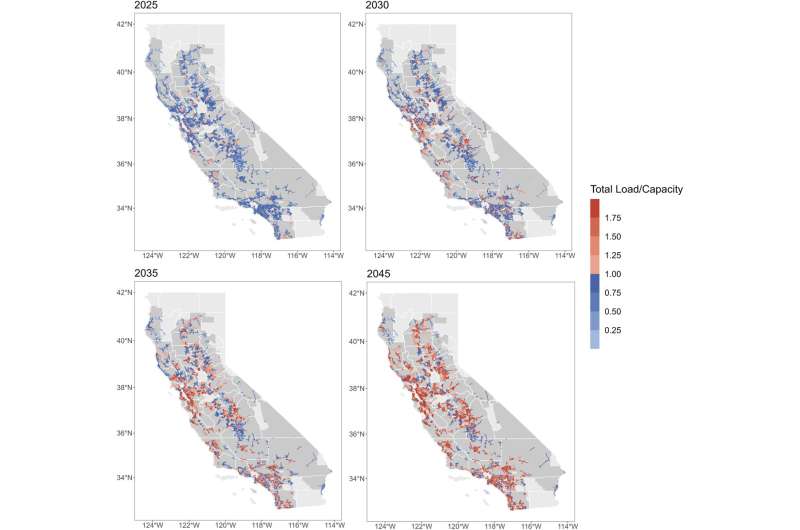Analysis of future EV load using real-world data shows major upgrade needed for California in the coming decades
A pair of environmental engineers at the University of California, Davis, has found that in order to meet the needs of the growing number of electric vehicles (EV) in that state in the coming decades, California power producers are going to have to produce more electricity and erect more power cables to carry the load to consumer locations.
In their paper published in the Proceedings of the National Academy of Sciences, Yanning Li and Alan Jenn describe their analysis of California’s electrical grid and how it will have to be changed to support the expected number of EVs running on its roads in the coming decades.
In 2022, California became the first state in the U.S. to ban the sale of gasoline-powered vehicles—the ban will be implemented in a stepwise fashion, with a complete ban taking place by 2035—cars already on the road will be allowed to continue to use gasoline with no restrictions.
For this new study, the research pair looked at the capacity of the state’s current grid system and then used it to make projections about future needs and costs to meet the demands of so many more EVs requiring power in the years ahead.
The researchers found that to meet such a sudden need, California will have to upgrade its capacity overall by 25%, which they suggest could cost up to $20 billion. They also found that such upgrades will likely have to happen more quickly in the most densely populated parts of the state, and that 67% of distribution circuits in the state will need upgrades by 2045.
They also noted that the huge increase in demand will lead to an overall rate reduction between $0.01 and $0.06/kWh by 2045.
The research pair also found that residential areas will require roughly twice as much more power to meet the coming demand as commercial areas, which suggests that power companies could reduce costs by adding more production to commercial areas—assuming that workers would be willing to charge their vehicles at work, rather than at home.
The research pair concludes by suggesting their work hints at the possible changes coming worldwide, as officials across the globe seek to move from gasoline powered cars to EVs.
More information:
Yanning Li et al, Impact of electric vehicle charging demand on power distribution grid congestion, Proceedings of the National Academy of Sciences (2024). DOI: 10.1073/pnas.2317599121
© 2024 Science X Network
Citation:
Analysis of future EV load using real-world data shows major upgrade needed for California in the coming decades (2024, April 29)
retrieved 30 April 2024
from https://techxplore.com/news/2024-04-analysis-future-ev-real-world.html
This document is subject to copyright. Apart from any fair dealing for the purpose of private study or research, no
part may be reproduced without the written permission. The content is provided for information purposes only.

Comments are closed